Deer seem to be all around, but even as a common species across Florida, many of us know surprisingly little about the white-tailed deer that span our state, support our economy, and sustain some of our endangered populations.
We “deer” you to learn more with us, so read on or watch the Wild Sarasota: White-tailed Deer Webinar.
White-tailed Deer (Odocoileus virginianus)
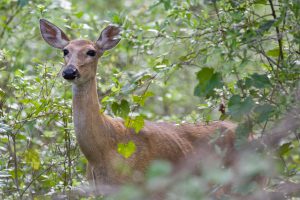
Florida is home to three different subspecies of White-tailed deer whose collective range spans the entire state — from Panhandle to the Florida Keys. The Florida coastal white-tailed deer (Odocoileus virginianus osceola) dominates the panhandle and Big Bend region, the rest of peninsular Florida is home to the Florida white-tailed deer (O. virginianus seminolus). The Florida Keys have their own endangered subspecies, the Florida Key deer (O. virginianus clavium).
Physical Description

At maturity, white-tailed deer average about 36 inches in height. They have a brownish coat accented by a white throat, belly, rump, tail underside, and inner ears. As fawns (juveniles), deer have white-spotted coats mimicking the speckled light of the forest floors where they are raised. Females (does) on average weigh ~90 pounds, with male bucks weighing ~125 pounds, although in North Florida deer may be much larger with bucks weighing in up to 190 pounds.
Florida Key deer are much smaller than the other subspecies within Florida standing at about 27 inches in height with males only weighing ~80 pounds.
Natural History
Deer can inhabit most habitats from oak hammock, scrub, and flatwoods to grasslands and wetlands. Their diet consists mostly of vegetation less than 5 feet off the ground whether that be leaves and tender tips of shrubs or acorns, mushrooms, and grasses foraged at ground level.
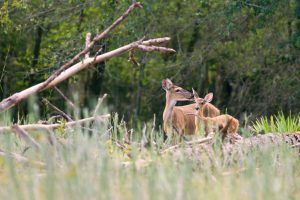
While deer are largely known to be crepuscular (most active during dawn and dusk), Florida white-tails are commonly active during the day and seeing one then is no cause for alarm. A universal characteristic of all 30 subspecies of white-tail deer in the Americas, however, is their “tail signaling.” Once made aware of a potential predator by their keen eyes or sense of smell, their tail goes erect and wags back and forth alerting those around them to potential danger.
Economics and Ecosystem Services Provided by Deer
White-tailed deer are the most economically important game species in Florida and across the United States. In 2011, Florida deer hunting brought in $95 million dollars in state and local taxes and supported almost 15,000 jobs. In addition to the economic benefits of deer hunting, maintaining deer populations is essential as a prey animal to sustain the Florida panther population. Generally, deer are also important in managing vegetation for a balanced ecosystem. Without the natural pruning efforts of these voracious herbivores, plant growth could get out of hand and alter habitats. We haven’t always paid such care to managing deer populations. In fact, in the 1930s and 40s statewide deer populations declined to only about 20,000 before recovery measures were put in place.
Have I had a visitor?

Think you may have had a deer visit while you were gone? Here are two tell-tale signs to confirm that a deer has been in your area:
Tracks
Identify deer tracks by their two pointed toes making a heart shape. Tracks are anywhere between 1-4 inches tall and .75-2.5 inches wide. Particularly clear tracks may include dots on the back which are dew claws – vestigial toe structures.
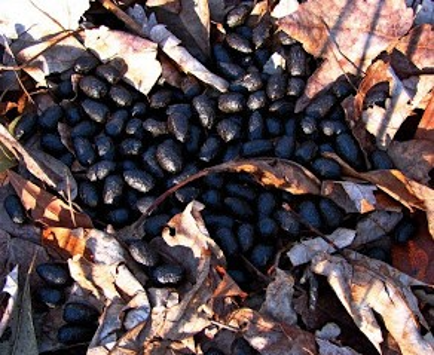
Scat
Deer scat is similar to rabbit scat, consisting of piles of ovalish, black pellets, whereas rabbit scat will be round and usually lighter brown. The more deer scat you see, the more deer you likely have in the area.
Fawns
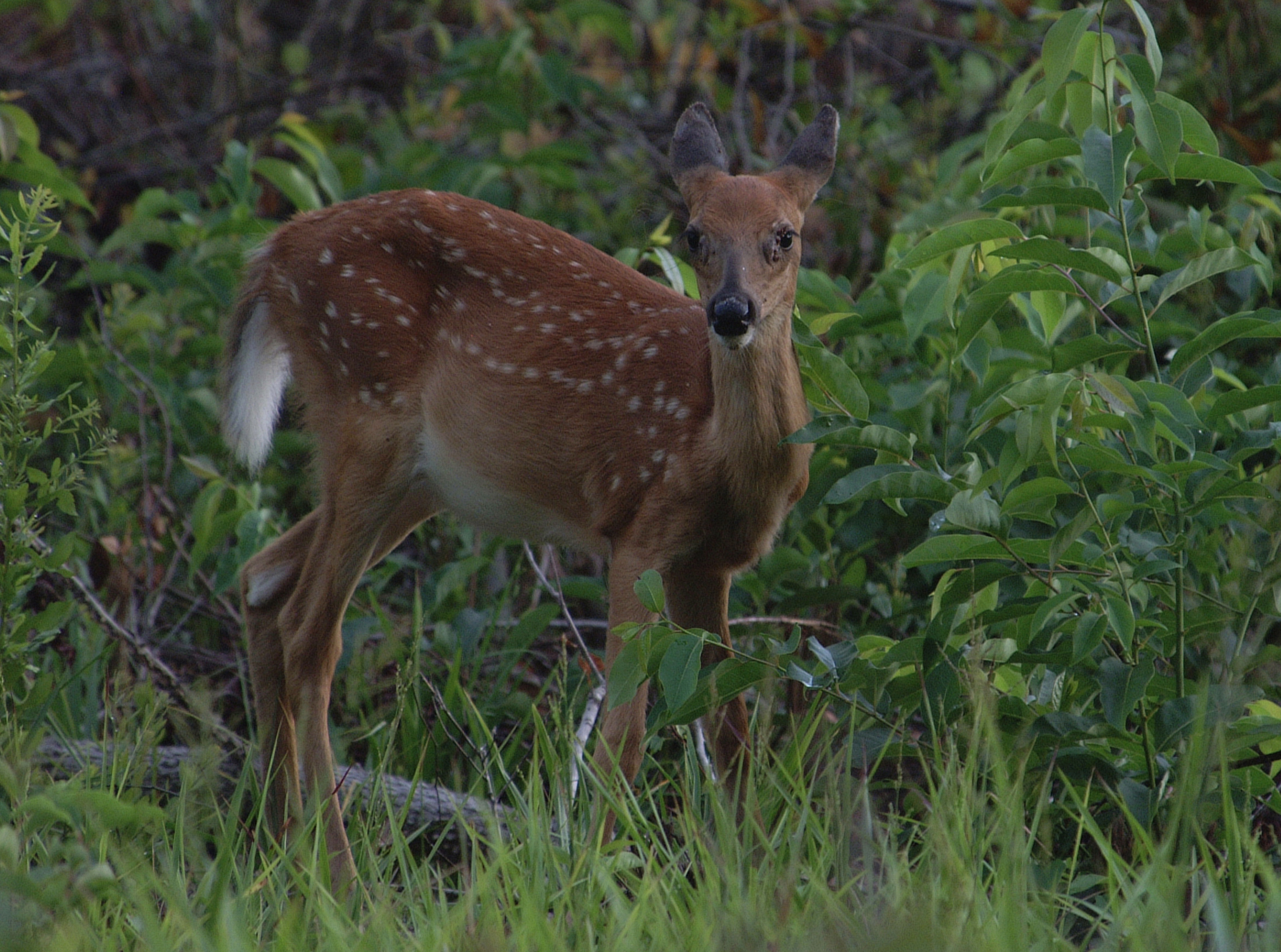
If you find a fawn alone, it is best to leave it undisturbed. In Florida, fawning season is variable and can be between March and September, often timed to avoid the rainiest time of year. Fawns are able to walk and even run within hours of birth, but do not follow their mothers around until they are 3-4 weeks old. Mother deer will leave fawns through most of the daylight hours while they go to browse for food. Fawns are uniquely camouflaged to blend into the light dappled forest floor and grassy or shrubby areas. Fawns are also uniquely adaptation in that they have little or no scent when they are young. A fawn alone is most often resting while their mothers are gathering the nutritious vegetation needed to make the milk to feed their fawns. If you are concerned, check back in the evening or the next day, chances are the fawn will be gone and back with Mom!
Deer Management
If you’d like to see less deer around – particularly near your flowerbeds – here are some tips:
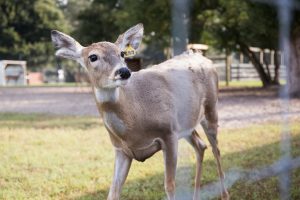
Install a fence and/or keep landscaping close to the house. The farther the deer have to venture, the less likely they are to eat your plants. Keep in mind that a fence less than 6ft tall likely won’t do the job as deer are excellent high jumpers.
Enlist the help of noise and motion. Wind chimes, pin wheels, motion-activated sprinklers, and dogs can startle deer and scare them off.
Just like humans, deers have acquired taste. Play around with different tastes and textures to try to save your more beloved plants. Some annuals that deer rarely eat include: Angelonia, Rudbeckia/Black Eyed Susan, Coreopsis (our state flower), Dusty Miller, Marigold, Vinca, Petunia, Salvia, and Verbena.
There are also repellents that can be added to beds or directly onto plants to deter these unwanted visitors. Read Coping with Deer Damage in Florida for more on deer management techniques.
Watch our Wild Sarasota webinar: White tailed-deer to learn more!
Read all our Wild Sarasota blogs HERE
Additional Resources
EDIS Wildlife of Florida Factsheet: White-tailed Deer
EDIS White-tailed Deer of Florida
If you notice unusual deer behavior (weight loss, excessive salivation, growths, or anything else out of the ordinary), contact FWC CWD hotline at (866) 293-9282.
 0
0
